PrAACtical Research: Aided Language Input for People with Developmental Disabilities
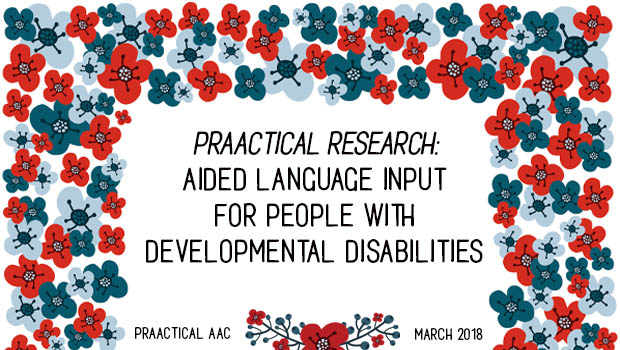
We’re pleased to welcome back Dr. Kathy Howery for another analysis of an AAC research article. Kathy is based in Alberta, Canada, and has worked in the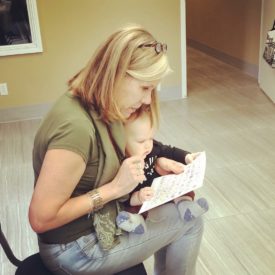 field of AT and special education for over three decades. In the past year, she completed her doctoral studies where she used phenomenological methods to seek to understand the lived experience of speaking with/through a speech generating device. Kathy is currently working as a consultant to schools and school districts across Alberta focusing primarily on children and youth with complex communication needs.
field of AT and special education for over three decades. In the past year, she completed her doctoral studies where she used phenomenological methods to seek to understand the lived experience of speaking with/through a speech generating device. Kathy is currently working as a consultant to schools and school districts across Alberta focusing primarily on children and youth with complex communication needs.
::::::::::::::::::::::::::::::::::::::::::::::::::::::;
Allen, A. A., Schlosser, R. W., Brock, K. L., & Shane, H. C. (2017). The effectiveness of aided augmented input techniques for persons with developmental disabilities: A systematic review. Augmentative and Alternative Communication, 33, 149-159.
What this Article is All About (The Focus of the Research)
This article presents the results of a systematic review of the research into what the authors refer to as augmented communication input (p.149). As the authors tell us in their introduction, today ‘clinicians often recommend that communication partners use the client’s AAC system to communicate’ (p.149), as it is believed to enhance both the learning of language form and content.
While this practice is commonly recommended, Allen et al. note that there are many different terms used to describe treatment protocols that the incorporate the technique of the communication partner using the AAC with an aided communication, including:
- Aided Language Stimulation (ALgS; Goossens’, 1989)
- System for Augmenting Language (SAL; Romski, Sevcik, Robinson, & Bakeman, 1994)
- Aided Language Modeling (ALM; Drager et al., 2006), and
- Aided AAC modeling (Binger & Light, 2007).
While it may seem that these terms all describe the same thing, ‘it is unclear whether these are essentially the same or have distinct features’ (p. 149). Allen, et al. bring forth and use another term, augmented communication input, first used by Beukelman and Garrett (1988) as an overarching phrase to describe the practice of using the client’s AAC device when speaking to the client.
Based on the how common this practice seems to be, the authors suggest that a systematic review of the available research is warranted. They acknowledge that there have been previous such reviews that have provided preliminary support for the effectiveness of augmented input, i.e. Biggs (2016) and Sennott, Light, and McNaughton (2016), but suggest these two previous reviews have several limitations in their approaches. The limitations that they point out in the Biggs study included not examining the effectiveness of augmented input on receptive communication, and having augmented input provided as part of a package intervention so therefore making it hard to understand what part of the package actually made the difference. In the Sennott, Light, and McNaughton study the authors suggest that limitations arise from not reporting on the intervention specifics (e.g. what was the treatment intensity, and what was the nature of the augmented input), which therefore makes it difficult to provide detailed recommendations for practice.
Allen, et al.’s review attempted to address what they suggested were limitations of the previous two reviews. In doing so they sought to:
- Determine the effectiveness of augmented input approaches both for persons with developmental disabilities and for persons with childhood apraxia of speech in terms of receptive vocabulary, expressive vocabulary, receptive syntax, and expressive syntax
- Catalogue, and if possible, establish categories of augmented input approaches,
- Catalogue and group outcomes targeted, and
- Provide a quality appraisal of the included studies.
What their Study Entailed
The review was multi-faceted. First, the authors searched for studies, both published and unpublished, that generally met the criteria of using augmented aided input with persons with developmental disabilities, including childhood apraxia of speech (CAS).
Next they selected studies that met their inclusion criteria: augmented input was an independent variable, augmented input was provided as part of a treatment study (but not a treatment package), participants had a diagnosis of developmental disability and/or CAS, the study was published in English, and for single subject studies effect size (a quantitative measure of the strength of the result) could be calculated.
After substantive search and review, 19 studies were found. Seventeen of these were single-case experimental designs and two studies were group designs.
The authors extracted nine variables from the studies. In order to help understand the findings, the 9 variables are listed in point form below, followed by a table that indicates what they found for each variable for each type of study design. While this is a lot of information to put into a research article review, it is felt that it is difficult to understand the overall implications of this review without having at least some measure of access to the details of what they found.Participant characteristics (i.e. diagnosis, severity, age, communication skills prior to intervention)
| In the 17 single case studies:
58 participants ranging in age from 2 to 25 years. 37 (63.7%) were male. Variety of diagnoses: Down syndrome (16), ASD (13), cerebral palsy (10), other (19). Formal receptive language results were reported for 55 participants, ranging from ‘no reliable response to a standard score of 113. Information on expressive skills before intervention was reported for 52 of the 58 participants. |
In the group design studies:
Study 1: 13 boys with moderate to severe intellectual disabilities Study 2: 43 boys and 19 girls with a variety of diagnoses. In both studies, participants produced no more than 10 spoken word approximations. All had hearing and vision within normal limits. |
- Study design for intervention, generalization, and maintenance
| Multiple baseline or multiple probe (80% of participants) | In the group design studies:
Study 1: success and effectiveness of participants’ communication with adults via SAL (SGD, graphic symbol input, encouragement of communicative attempts) Study 2: Comparison of three randomly assigned interventions: AC-I, adult modeled SGD use/no direct demand on child; AC-O, adult hand-over-hand to get child to use SGD; SC, adult-focused on getting child to produce sounds. |
- Intervention characteristics (i.e., length and frequency of sessions, dosage of augmented input)
| In the 17 single case studies:
Differences in describing interventions: 10 used a term other than aided input Five – aided AAC modeling (can involve auditory and visual input from an SGD) Three – AlgS (use static communication boards with mentor’s natural speech) One – ALM (use static communication boards with mentor’s natural speech) One – Natural Aided Language Stimulation (use static communication boards with mentor’s natural speech)
Substantial variability in total number of sessions per participants (from 4 to 135) and intensity (one session weekly to daily). Four studies had no information on intensity.
7 did not report on dosages Reported dosages ranged from ‘every opportunity’ to 30 models per 15-min session. |
In the group design studies:
Number of trials was not specified in either study as treatment was presented in a naturalistic fashion. The context for both studies was leisure/play and snack. |
- Outcomes measured (i.e., receptive/expression vocabulary, receptive/expressive syntax, pragmatic)
| In the 17 single case studies:
There were several outcomes. Outcomes were grouped by category: Receptive vocabulary – learner was given a spoken word/symbol and responded by pointing to an object (17 participants) Expressive vocabulary – learner answering the question “what is this?’ (22 participants) Expressive syntax – required the learner to produce multi-symbol utterances (30 participants) Pragmatics – involved the use of the communication system in context e.g. number of activations (44 participants) Receptive syntax – no outcomes in this category
|
In the group design studies:
The first study measured the proportion of communication events via SAL that were successful, and the proportion of successful events that were effective. The second study measured: · Vocabulary size · Augmented and spontaneous spoken word size and use, and · Communication interaction skills.
|
- Format of visual input (i.e., interface design, symbol type, organization)
| In the 17 single case studies:
A variety of visual input. Of the 58 participants: · 6 received visual input via combination of gesture and object · 3 received visual input via gesture and line drawing · 49 provided visual input via grid displays Display: o 25 used screen-based displays o 22 used paper-based displays o 2 not specified Symbols organization: · 25 semantic-syntactic · 10 topic-based · 2 taxonomic · 3 semantic compaction · 9 not applicable (e.g. grid too small) or not specified · 50 received visual input via Picture Communication Symbols, personal photos, or other graphic symbol set · 6 used non-iconic graphic symbols (i.e. Lexigrams) · 2 did not specify symbol set · 17 specified presence or absence of text with graphic symbol · 41 did not specify |
In the group design studies:
The first study provided visual input in the form of Lexigrams. The second study AC-I and AC-O conditions received visual input in the form of Picture Communication Symbols on SGDs. Graphic symbol organization was not specified.
|
- Format of auditory input (i.e., mentor’s voice, synthetic speech, digitized speech, word correspondence)
| In the 17 single case studies:
*Please note the paper describes these results only by percentages (some of which I am still finding confusing) as opposed to as numbers of participants and percentages as was reported for other variables. 62.1% of included participants reported use of experimenters live voice · For 72% of participants, it was not specified if auditory input was from synthetic or digital speech · For 86.2% of participants information on the correspondence between auditory input relative to the full message being communicated (i.e. auditory input of keywords in sentence being communicated vs. auditory input for every word) o 67.2% keyword correspondence · For 13.8% nature of correspondence was not reported. |
In the group design studies:
In both studies, auditory input was provided by the communication partner’s voice and the SGD. |
- Other intervention features (i.e., whether communicative attempts were encouraged, the existence of a message window, use of text, presence of explicit models)
| In the 17 single case studies:
· 7 studies used recasts or expansions · 4 studies actively encouraged communicative attempts · 5 studies provided a repeated model of the target utterance · 3 did not specify any additional strategies |
In the group design studies:
In the first study participants received encouragement for communication attempts. In the second study · AC-O and SC received encouragement (AC-I did not). · AC-I and AC-O involved recasts and expansions.
|
- Effectiveness (in single case studies using the statistical method of Percentage of Non-overlapping data; in group designs using the reported statistics of eta squared and partial eta squared).
| In the 17 single case studies:
As the PND, PEM, and PAND scores are difficult to interpret if one is not familiar with such statistics. What can be understood from the study is that there was a range from ineffective/unreliable to highly effective in intervention outcomes, in generalization outcomes, and in maintenance outcomes. |
In the group design studies: The first study indicated that the SAL condition was more effective than the non-SAL condition (although due to small sample size statistical difference was not assessable) In the second study, the AC-O and the AC-I interventions were seen to have a positive effect in the number of spoken/augmented produced words, increased vocabulary size, and communication interaction, which increased significantly. |
- Study quality (based on the evaluative method for determining evidence-based practices in autism (Reichow, 2010)).
| Of the 17 single case studies, five were classified as strong, eight were classified as adequate, and four were classified as weak. | · Both the group studies were rated as ‘adequate’. |
Overall Summary of Results
- Although all the interventions included speech augmented by components of the AAC, there were differences in the terms used to describe the aided input and also considerable differences in aspects of the incoming language and in the AAC systems themselves.
- There was considerable variation in the interventions across the studies in terms of intensity and dosage. Dosage (frequency of augmented input) was often not reported at all.
- Inputs varied, both in terms of visual and auditory inputs. While mention might be made of the visual symbols/displays (paper-based/device; type of symbols; etc) there was inconsistency or no information on whether text was also present, or the presence/absence of a message window. In terms of auditory inputs, both the voice of the communication partner and the output from an SGD were reported but often the source and the type of auditory inputs were not made clear.
- Confirming the Sennott et al. (2016) and Biggs (2016) studies, this review indicated that augmented input had been studied in relation to changes in expressive and receptive vocabulary, pragmatics, and expressive syntax, but there is not yet evidence regarding the effect of augmented input on receptive syntax.
What the Authors Learned from Their Study
- Allen et al conclude, based on Reichow (2010)’s definition of a ‘promising’ evidence-based practice, that the evidence for augmented input for improving communication skills in persons with developmental disabilities and CAS is promising (p.156). However, they go on to state ‘the variety of augmented input approaches along with the targeted outcomes used in these studies, as well as the variety of ages, diagnoses and skill levels of participants make it difficult to legitimately consider the approaches as “a treatment” as stipulated by Reichow’ (p.156).
- They note that many of the studies that were rated as ‘strong’ in quality ‘involved participants whose formal receptive language was slightly below or below average. This could then inflate expectations regarding augmented input for children with cognitive impairment.
- The authors suggest that ‘ without augmenting more complex syntactic structure to improve comprehension, it may be unlikely that children who require AAC will use more advanced language forms (p. 156).
- While many of the studies used naturalistic communication tasks, they outcomes measured were generally related to single symbol comprehension or production tasks. “It is therefore unclear whether the skills gained can be generalized to naturalistic aided communication scenarios” (p. 156).
- All studies rated as strong used either the aided AAC modeling or ALM approaches which include protocols that are relatively rigid and more clearly defined in terms of intensity and dosage.
- Finally, the authors conclude given the heterogeneity and variability seen across the studies, ‘augmented input interventions do not reach the threshold required to be an empirically-supported intervention’ (p. 157).
Why is this article important for practice?
As Allen et al state, ‘when working with individuals with little or no functional speech, clinicians often recommend that communication partners use the client’s augmentative and alternative communication (AAC) device when speaking to the client’ (p. 149). I might go so far as to say augmented input, modeling or aided language stimulation has become not only a common recommendation, but a core practice in the field of AAC (see for example, https://praacticalaac.org/praactical/aac-strategies-round-up-aided-language-input/, or https://aaclanguagelab.com/files/130627aidedlanguagestimulationresource.pdf , or https://www.iidc.indiana.edu/pages/Using-Aided-Language-to-Develop-Skills-with-Augmentative-Communication-Displays as a few examples of places where this approach is discussed and promoted).
With this embracing of augmented input in mind, this review is important in that it gives credence to the practice, suggesting that broadly stated augmented input is a promising practice. Yet, it is a cautionary tale as the evidence is not there to say what exactly the empirically-supported aided/augmented input intervention would or should look like. As Allen et al. state in their concluding remarks, ‘the variety of approaches, target outcomes, and participants, along with lack of consistent detail regarding the interventions make it difficult to develop recommendations on how to best implement these strategies’ (p. 157).
At one point in their discussion, Allen et al recommend that practicing clinicians utilized the aided AAC modeling or ALM protocols as these were the protocols employed in studies rated strongest in terms of quality. Quality studies are generally stated those that detailed most specifically the how, what, how much, with what, and to whom augmented input was provided. Understanding this specificity and employing a specific and well documented approach to augmented input is certainly needed in future studies, and would also help practitioners in being intentional about what they mean when they recommend aided language, modeling or the like, and could also ‘allow clinicians to manipulate their treatment protocols in response to or lack of response to intervention’ (p. 156).
Clearly more is needed to be understood about augmented input in order to take a promising approach that the field is embracing and seemingly seeing success within practice to something that can be approached with a clearer understanding of what is meant, and what it really ‘looks like’ when it is done appropriately and well.
Some thoughts:
In attempting to unpack and summarize this paper a few thoughts kept coming up for me.
- We really have so much to learn about how to appropriately support children who need to become aided communicators. While it seems widely accepted that “ Children who use AAC need exposure to language forms, via communicative input within their environment, before they can effectively use those forms as output (Allen, et al, 2017, p. 156), it is still an art and science that we really know little about. People (including I must say myself) talk about learning an AAC system like learning another language (see for example https://www.youtube.com/watch?v=vUY6oQoSTXw ), but is it? Not really. AAC maps graphic symbols onto spoken language, the spoken language (of the ‘mouth talkers’) is still primary and thoroughly privileged. When deaf children are learning ASL, when children are learning a second language, and when talking children are learning language they are going to speak the language in which they are immersed. How can a child who is learning to use an aided language system ever really be immersed?
- If we really were to try and find an immersive environment would all communication become so slow as to be rendered ineffectual? I think this goes to the idea of how many words to ‘model’ when using augmented input. Should we as some of the reviewed studies did (and is often in my experience suggested) only model key words? Or should we really be speaking to the child with their language all the time, every word? Certainly, the authors raise this issue, but they do not raise the issue of time and timing of interactions, and at what point the augmented input might jeopardize the whole communicative interaction. I wonder about this.
- I wonder about the experience of adults who are so-called ‘competent’ communicators. Did they have people that provided augmented input? What kind, how much, and to what extent? Might their reflections on this topic and their memories of learning to speak with/through an aided system provide those of us in the field who are wondering with information that could inform practice, and indeed inform research, as certainly more research into this practice or set of practices is warranted.
Filed under: Featured Posts, PrAACtical Thinking
Tagged With: aided language input, augmented input, Kathy Howery, research
This post was written by Carole Zangari

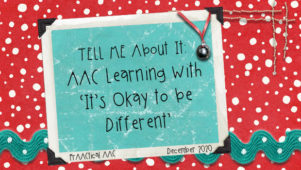
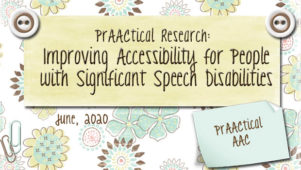
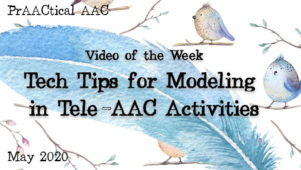
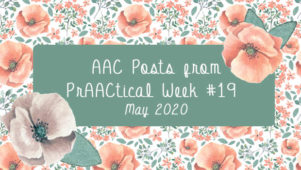
2 Comments
What a great review. This really made me sit and think … how I’m doing my modeling and what am I doing to make sure it’s making a difference for the person who is using AAC. Thank you!
Thanks Kathy! A model of clear analysis!
The weird thing for me about the current discussion around modeling is the conflation of the techniques of modeling for SGDs and for communication boards. Simply because both use pictures they cannot be the same thing. In the original Aided Language Stimulation (ALgS; Goossens’, 1989) article the authors expressly draw the analogy to signing because as they rightly observe their subject, Jessica, can only learn the words associated with pictures through use. At a conversational level, they were trying to model communication with a board. This can only physically work if the partner can see the board.
When we discuss modeling with SGDs we need to remember devices talk (the SG bit!). The conversations we are trying to achieve involve ideally not being able to see how the user of the device generated the language they produced, but simply understanding what was said. (Surely that goal is a fairly common reason to give a kid an SGD?). I cannot believe that modeling for devices and boards can be identical. Clearly different things, not just word production need to be modeled.
In general conversation about AAC I get the impression the confusion about what modeling is, apart from being “A GOOD THING” leads to the view that if the partner touches the device that counts as modeling and if she or he doesn’t, then it wasn’t modeling. My worry is that a simple bit of common sense “if you want to teach someone to do something, learn it yourself first” is being invested with magical powers. Being able to talk using a kids device is not the culmination of teaching AAC, it is the basic prerequiste for everything else.
Fun Fact: There was a time just 25 years ago when suggestions for good practice often included the injunction “Never Touch the Kids Device – because you wouldn’t put your fingers in his mouth, either!”
plus ca change plus c’est la meme chose!